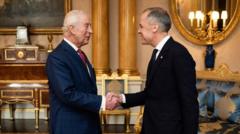In a surprising turn of events, Prime Minister Mark Carney's invitation to King Charles III to deliver the Throne Speech at the opening of Canada’s 45th parliament signifies an important evolution in Canada's relationship with the British monarchy. This invitation serves not only to reinforce Canada's identity but also challenges the narrative coming from U.S. President Donald Trump, who has repeatedly suggested that Canada resembles a "51st state."
Historically, the ties between Canada and the monarchy have been complex. A decade ago, former Prime Minister Stephen Harper's government faced backlash for attempting to highlight these connections through symbolic gestures, such as replacing prominent artworks with a portrait of the Queen. The turn of events in Canada’s political landscape, particularly following the election of Justin Trudeau, led to the unsparing removal of royal symbols and a growing push for independence from ancestral ties.
Fast forward to 2025, the narrative has changed. Carney’s invitation represents a conscious effort to affirm Canada's sovereignty at a critical juncture. Royal historian Justin Vovk suggests that this act is a “theatrical display” of what distinguishes Canada from its southern neighbor and aims to demonstrate that Canada values its unique identity, going beyond Trump's rhetoric.
Canada's political history reflects a slow, yet steady separation from the monarchy—marked significantly by the repatriation of its constitution in 1982 under Pierre Trudeau. This move granted the nation full legislative autonomy, while maintaining a constitutional monarchy. Carney's invitation signals a renewed support for the Crown that may shift public sentiment toward appreciation of its ceremonial role, even as many Canadians remain indifferent or critical of the monarchy.
Carney’s decision brings King Charles III back to Canada for the first time in his reign, making the upcoming visit particularly historic given that a British monarch has not addressed the Canadian parliament since 1977. With the relationship between the U.S. and Canada under pressure due to Trump's tariffs and sovereignty undermining remarks, Carney views the King’s visit as vital for reinforcing national pride and international partnerships.
By inviting the King, Carney not only seeks to establish a stronger symbolic relationship with the monarchy but also aims to enhance ties with Europe during a time when Canada is navigating shifting global alliances. This alignment could serve as a stabilizing force in an unpredictable political climate.
Although there are calls from some Quebec politicians to sever ties with the monarchy as part of a broader push for independence, the arrival of the King and the Queen promises a socially engaging experience for many Canadians who appreciate the pageantry of royal visits. As expressed by Vovk, the overarching goal remains "to send a political message from Canada to the world," signaling unity and national resilience in the face of external pressures.
In conclusion, the King's visit not only affirms the Crown's significance in a modern Canada but also indicates a concerted effort by Carney's government to resonate with both historical ties and contemporary challenges.





















